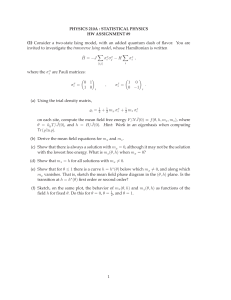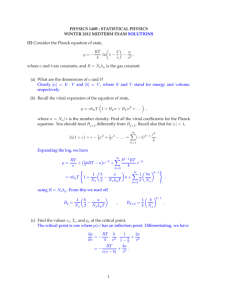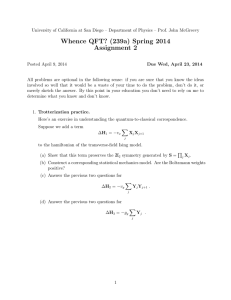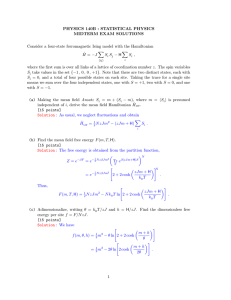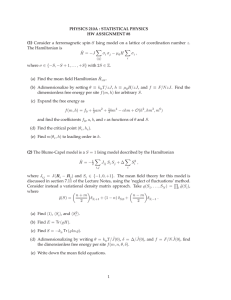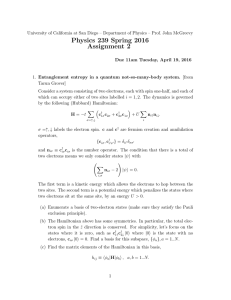RNG: 1d Ising Model
advertisement
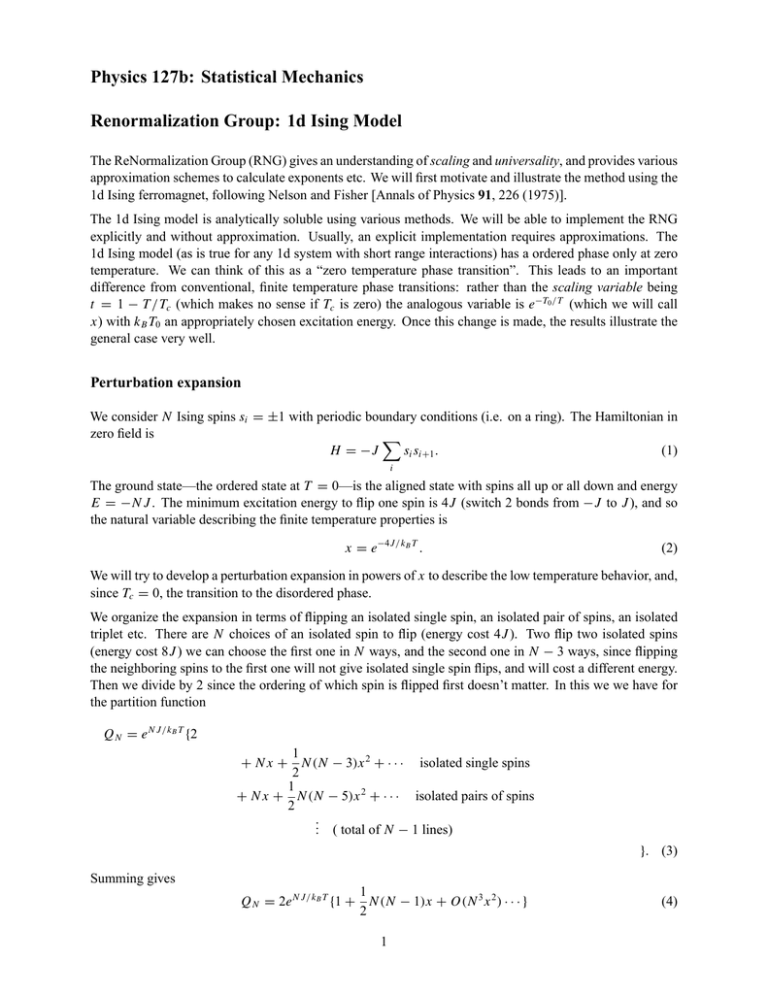
Physics 127b: Statistical Mechanics
Renormalization Group: 1d Ising Model
The ReNormalization Group (RNG) gives an understanding of scaling and universality, and provides various
approximation schemes to calculate exponents etc. We will first motivate and illustrate the method using the
1d Ising ferromagnet, following Nelson and Fisher [Annals of Physics 91, 226 (1975)].
The 1d Ising model is analytically soluble using various methods. We will be able to implement the RNG
explicitly and without approximation. Usually, an explicit implementation requires approximations. The
1d Ising model (as is true for any 1d system with short range interactions) has a ordered phase only at zero
temperature. We can think of this as a “zero temperature phase transition”. This leads to an important
difference from conventional, finite temperature phase transitions: rather than the scaling variable being
t = 1 − T /Tc (which makes no sense if Tc is zero) the analogous variable is e−T0 /T (which we will call
x) with kB T0 an appropriately chosen excitation energy. Once this change is made, the results illustrate the
general case very well.
Perturbation expansion
We consider N Ising spins si = ±1 with periodic boundary conditions (i.e. on a ring). The Hamiltonian in
zero field is
X
H = −J
si si+1 .
(1)
i
The ground state—the ordered state at T = 0—is the aligned state with spins all up or all down and energy
E = −NJ . The minimum excitation energy to flip one spin is 4J (switch 2 bonds from −J to J ), and so
the natural variable describing the finite temperature properties is
x = e−4J /kB T .
(2)
We will try to develop a perturbation expansion in powers of x to describe the low temperature behavior, and,
since Tc = 0, the transition to the disordered phase.
We organize the expansion in terms of flipping an isolated single spin, an isolated pair of spins, an isolated
triplet etc. There are N choices of an isolated spin to flip (energy cost 4J ). Two flip two isolated spins
(energy cost 8J ) we can choose the first one in N ways, and the second one in N − 3 ways, since flipping
the neighboring spins to the first one will not give isolated single spin flips, and will cost a different energy.
Then we divide by 2 since the ordering of which spin is flipped first doesn’t matter. In this we we have for
the partition function
QN = eNJ /kB T {2
1
+ N x + N (N − 3)x 2 + · · · isolated single spins
2
1
+ N x + N (N − 5)x 2 + · · · isolated pairs of spins
2
..
. ( total of N − 1 lines)
}. (3)
Summing gives
1
QN = 2eNJ /kB T {1 + N (N − 1)x + O(N 3 x 2 ) · · · }
2
1
(4)
and for the free energy per spin
1
f = −J + kB T { (N − 1)x + · · · }.
2
(5)
We see that in the thermodynamic limit the series diverge due to the possibility of thermal fluctuations over
an infinite range of length scales (one spin flipped, a pair flipped,… half the spins flipped). For the 1d Ising
model these fluctuations all have identical energy! This is indeed a special feature of the one dimensionality,
but in higher dimensions fluctuations over all length scales indeed become important at the transition point.
Conclusion: T = 0, B = 0 is a critical point of the 1d Ising model. Taylor expansions about this point
break down. In fact we will see that the expansion is nonanalytic, e.g.
J
f
=−
+ x 1/2 + · · ·
kB T
kB T
(6)
with a nontrivial exponent 1/2.
Renormalization Group
The key idea is not to try to treat all length scales in one shot. Instead use an iterative procedure to first
treat short length scales, and study their effect (“renormalization”) on the next larger scale etc. Furthermore,
rather than studying how the free energy varies with parameters of a fixed Hamiltonian, the RNG studies
how the Hamiltonian evolves to maintain a fixed free energy under the elimination of successive length scale
fluctuations.
For the 1d Ising model we can proceed completely analytically. For convenience let as define a reduced
Hamiltonian
X
X
H
H̄ = −
=K
si si+1 + h
si + CN
(7)
kB T
i
i
with K = J /kB T , and h = µB/kB T , and we have added a “zero of energy” constant CN for complete
generality. A convenient definition of the corresponding partition function is
Q̄N =
Y1 X
i
2 s =±1
eH̄ ({si }) = T rN (eH̄ )
(8)
i
where the notation T rN is introduced to denote the trace over all configurations of the N spins. Note that we
have added an extra factor of 1/2 in the “trace”, i.e. T rN is an average, rather than the mathematical trace.
This corresponds to subtracting the entropy term N kB T ln 2 from the free energy, so that
−kB T ln Q̄N = A − N kB T ln 2.
(9)
The free energy we calculate from Q̄N is therefore the deviation from the free spin result—precisely the
quantity we are interested in.
Rather than doing the T rN all at once, we do the trace operation (i.e. average) over the states of every other
spin (or in general every bth spin, leaving a fraction (b − 1)/b remaining—we are doing the case b = 2).
Consider first the effect of averaging over the states of a particular spin s with neighbors s+ and s− . Focus
your attention on the terms in the product in Eq. (8) for QN involving the spin s
T rs =
1 X
1
1
. . . eKs− s+ 2 h(s− +s)+C eKss+ + 2 h(s+s+ )+C . . .
2 s=±1
= . . . e 2 h(s− +s+ )+2C cosh(Ks− + Ks+ + h) . . . .
1
2
(10a)
(10b)
(Notice that we consistently associate half the magnetic field term and the constant term with the “backward”
bond, and half with the “forward bond”). Obviously the variable s no longer occurs in Q̄N —we have done
the necessary average over its two possible configurations. No approximation has been made, and repeating
this procedure correctly evaluates Q̄N .
Now we would like to automate this scheme by setting up an iterative procedure. We can try to do this by
rewriting Eq. (10) in terms of a new effective Hamiltonian involving s+ and s− (the rest of the terms in the
product for Q̄N are, so far, unchanged). In the present case this new Hamiltonian takes the same form, but
with changed (renormalized) parameters.
We look for K 0 , h0 , C 0 so that
0
1 0
e 2 h(s− +s+ )+2C cosh(Ks− + Ks+ + h) = eK s− s+ + 2 h (s− +s+ )+C
1
0
(11)
for all choices of s− , s+ = ±1. Since there are 4 states of s− and s+ , and only 3 parameters, it is not
immediately clear that this can be done. Indeed usually, i.e. more realistic systems or higher dimensions, it
will not be possible, and the Hamiltonian must be made more complicated as the iteration proceeds. However
in the present case the only quantities appearing, namely s− s+ and s− + s+ , depend only on whether the
spins are ↑↑, ↓↓, or (↑↓ or ↓↑), i.e. only three different possibilities, so the three parameters are enough to
satisfy Eq. (11). Explicitly
0
0
0
eh+2C cosh(2K + h) = eK +h +C ,
e2C cosh(h) = e
e
−h+2C
cosh(−2K + h) = e
−K 0 +C 0
,
K 0 −h0 +C 0
(12a)
(12b)
.
(12c)
The solutions are easily obtained by multiplying various combinations
0
cosh(2K + h)
cosh(2K − h)
cosh(2K + h) cosh(2K − h)
=
cosh2 h
8C
= e cosh(2K + h) cosh(2K − h) cosh2 h
e2h = e2h
e4K
e
0
4C 0
(13a)
(13b)
(13c)
(e.g. the first equation is given by dividing the first of Eq. (12a) by the third).
Recursion Relations
Clearly this procedure can be repeated for every other spin, and we end up with a system with the same free
energy with N/2 spins, twice the lattice spacing, and described by the same Hamiltonian but with parameters
K 0 , h0 , C 0 . The final step of the renormalization group is to rescale lengths down by a factor of b (2 in our
case), so that the lattice “looks the same”.1 This gives us the “scale factor b = 2” renormalization group
H̄ 0 = Rb [H̄ ]
(14)
defined by the recursion relations Eq. (13) which can be written
K 0 = RK (K, h),
0
h = Rh (K, h),
0
C = bC + Rc (K, h).
(15a)
(15b)
(15c)
1 The number of spins is N/2,down by a factor of b, but remember we are interested in the free energy density in the N → ∞
limit.
3
x'
x'=4x/(1+x)2
x2
x1
x0
x1
x2
x3
x
1
Figure 1: Recursion relation for the temperature variable x in the 1d Ising model. Fixed points are at x = 0
and x = 1. The “steps” yield successive values of xl under the recursion.
Note that the constant term does not appear in the recursion relations for K, h, and only as a simple additive
piece in the recursion relation for C. It keeps track of the contribution to the free energy coming from the
variables averaged over. We will concentrate on the evolution of the interaction parameters K, h, and so will
not consider the third equation further.
Remember that the partition function and so the free energy is preserved by the transformation, so we have
for the free energy density
f [H̄ 0 ] = bd f [H̄ ] = 2f [H̄ ]
(16)
corresponding to the thinning out of the spins (or the shrinking of the full lattice). Similarly the correlations
between the surviving spins is preserved, so that for the correlation length
1
ξ [H̄ ]
(17)
2
again corresponding to the trivial shrinking of the lattice. Equations (16),(17), although trivial, will later be
important in understanding the content of the RNG.
ξ [H̄ 0 ] = b−1 ξ [H̄ ] =
We can now successively repeat the elimination i.e. solve the problem by iteration.
First consider h = 0. Equation (13a) becomes
1
0
e4K = cosh2 (2K) = (e2K + e−2K )2
4
(18)
or for x = e−4K
4x
.
(19)
(1 + x)2
The iteration of this equation can be understood graphically Fig. 1. The two fixed points defined by x 0 = x
play a key role. At a fixed point the renormalization does not change the Hamiltonian. Equation (17) then
shows us that ξ must be zero or infinite at a fixed point.
x0 =
The x = 1 (i.e. K → 0) is the high temperature fixed point. The interactions renormalize to zero, and
the behavior is simple. There are no large length scale phenomena, and the correlation length is zero. This
4
fixed point is stable or attracting—starting from any initial value of x 6= 0 eventually leads to this fixed
point. Physically, any finite temperature state, inspected at long enough length scales, looks like the infinite
temperature solution, i.e. is disordered.
The x = x ∗ = 0 fixed point is the nontrivial critical fixed point. The corresponding fixed point Hamiltonian
H̄ ∗ = H̄ (x ∗ , h∗ = 0) satisfies
Rb [H̄ ∗ ] = H̄ ∗ .
(20)
The fixed point corresponds to K → ∞, and so to nontrivial behavior. This state has an infinite correlation
length ξ → ∞. Note that this fixed point is unstable or repelling. This is a key result:
The properties of the unstable, critical fixed point determine the physical behavior in the critical
regime near the transition temperature.
The fixed points tell us particularly simple behavior. The recursion relations under the renormalization
procedure allow us to relate the physical Hamiltonian (some given K or x and h) to another Hamiltonian.
For example if we iterate many times, eventually the Hamiltonian for any nonzero temperature is related to
the Hamiltonian at the high temperature fixed point, where the properties are easy to calculate. This gives a
tractable scheme for calculating a subset of behavior, namely the long length scale behavior that is left after
the elimination processes. Of particular interest is the behavior as T → 0. This means the physical system
corresponds to a value of x close to the unstable fixed point. We can understand properties of the system
(beyond the simple fact that the state is disordered) by studying how x “flows away” from the unstable fixed
point under the iteration procedure.
Critical Behavior
The critical behavior (i.e. x small) may be understood by linearizing about the unstable fixed point. Write
the physical value of x as x0 , and assume
x0 = x ∗ + δx0
(21)
with δx0 small. Then under each iteration of the RNG we find by linearizing Eq. (19) that δx is simply
multiplied by 4, so that after some chosen number l iterations
δxl = (3x )l δx0
with 3x = 4
(22)
where 3x is an eigenvalue of the linearization of the recursion relations about the fixed point x = x ∗ . This
allows us to relate the physical behavior at x0 to the behavior we calculate with the renormalized Hamiltonian
given by xl = x ∗ + δxl . In particular we have for the free energy density
f (x0 ) =
1
f (xf = 3lx x0 )
2l
(23)
for x0 small, where we have used the fact that x ∗ is zero. This result is good providing l is not so large that
xf is no longer small. A trivial-sounding statement, but another key point is:
The trick of using the renormalization group at a critical point is to choose the number of iterations
l so that something is learned (e.g. from the right hand side of Eq. (23)).
We often want to know the behavior as x is varied towards the critical point (T → Tc ). Let us choose l so
that as x0 varies, xf remains fixed at some small value so that the linearization remains valid. This means
that we choose
ln(xf /x0 )
l=
.
(24)
ln 3x
5
Then2
f (x0 ) = 2− ln(xf /x0 )/ ln 3x f (xf )
=
(25)
ln 2/ ln 3x − ln 2/ ln 3x
[xf
f (xf )].
x0
(26)
The first term tells us what we want to know—how does the free energy depend on the initial x (and so on
temperature). The second term in the brackets does not depend on x0 , and is just a constant prefactor in the
x0 dependence.
Thus we have found for small x
f (x) = Ax 1/λx
with
λx =
ln 3x
= 2.
ln 2
or in conventional notation
f (x) ∼ x 2−αx
with
αx = 2 −
1
,
λx
(27)
(28)
The nontrivial power law dependence on x (i.e. square root) corresponds to the power law dependence on t
at a finite temperature phase transition. Similarly
ξ(x0 ) = 2l ξ(xf )
(29)
so that following the same procedure
ξ ∼ x −νx
with
1
.
λx
νx =
(30)
Notice that the hyperscaling relation 2 − αx = dνx is satisfied (remember d = 1 here): hyperscaling follows
directly from the scaling of f with b−ld and the correlation length with bl .
Scaling of the field
Now we include the field h. The critical fixed point is x ∗ = h∗ = 0. The recursion relation for h can be
written
h
e + xe−h
1
0
h = h + ln −h
.
(31)
2
e + xeh
Linearizing about the fixed point gives
δh0 = 2δh
(32)
and the equation for δx is unchanged. Thus, in general notation
δx 0 = 3x δx
0
δh = 3h δh
with
3x = bλx
and
λx = 2,
(33a)
with
λx
and
λh = 1.
(33b)
3h = b
(More generally we might expect a matrix equation
0 δx
? ?
δx
=
δh0
? ?
δh
(34)
2 We often have to manipulate exponent expressions such as 2− ln(xf /x0 )/ ln 3x , where we want to look at the dependence on
xf /x0 behavior. To do this write the expression as exp[− ln(x/x0 ) ln 2/ ln 3x ] which can then be rewritten (x/x0 )− ln 2/ ln 3x .
6
and then we would have to diagonalize to find the two eigenvalues, and the different linear combinations of
δx and δh that diverge exponentially from the fixed point.) So now iterating l times from the initial values
(x0 = x, h0 = h) near the fixed point (0, 0)
xl = 2λx l x
hl = 2
and
λh l
(35a)
h
(35b)
f (x, h) = 2−l f (xl , hl ).
(36)
Again choose l so that xl is some small fixed value xf as x varies
2l = (xf /x)1/λx
so that
f (x, h) =
x
xf
1/λx
f (xf ,
(37)
x λh /λx
which can be written in the form
f (x, h) = A x 2−αx Y (D
f
x
h
)
x 1x
h),
(38)
(39)
and we have derived the scaling form with exponents
1
1
= ,
λx
2
λh
1
1x =
= .
λx
2
2 − αx =
7
(40a)
(40b)

